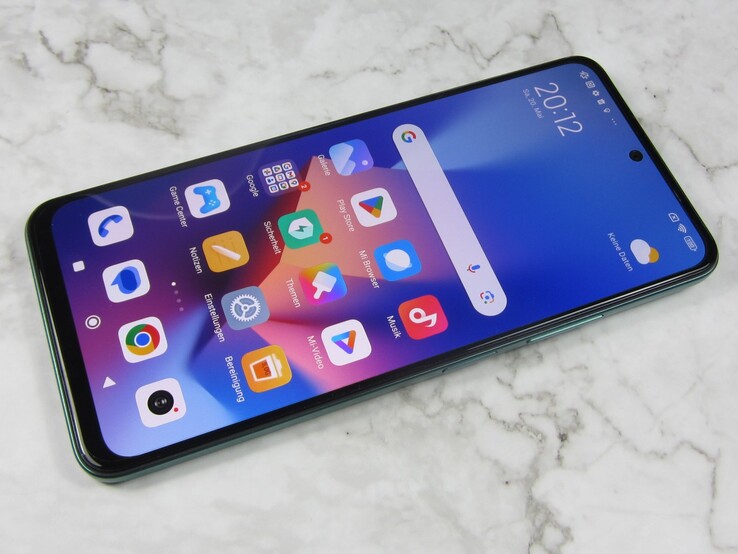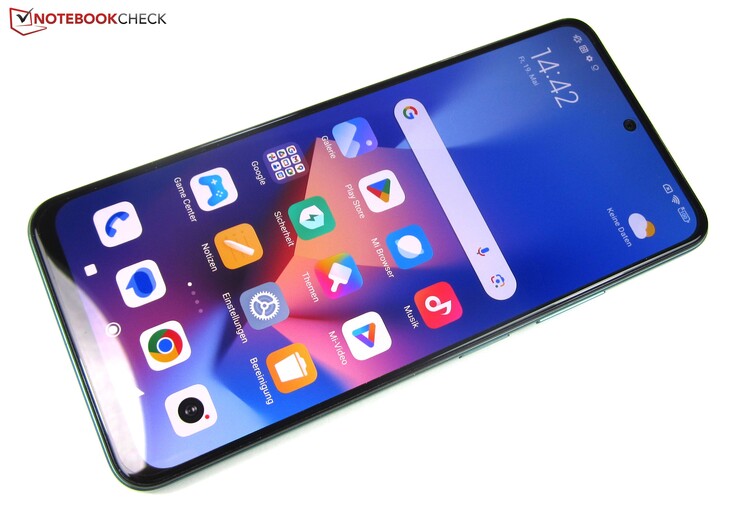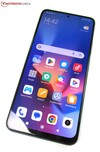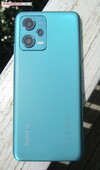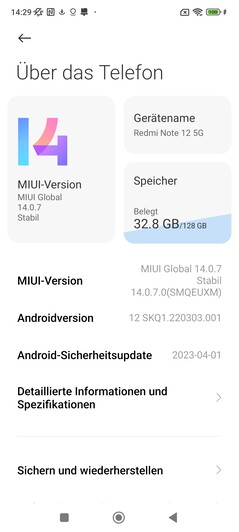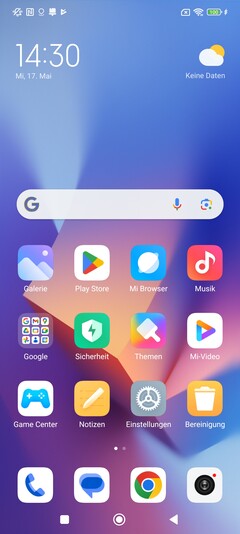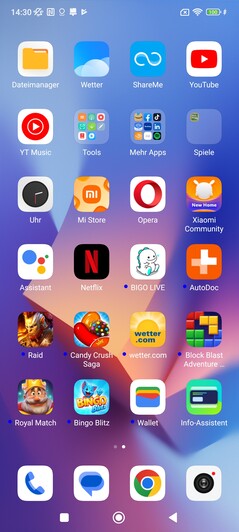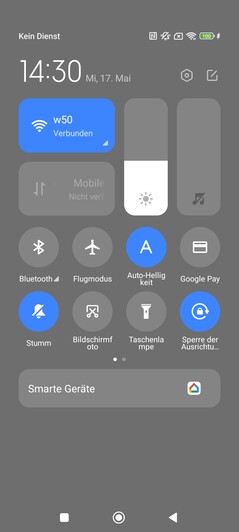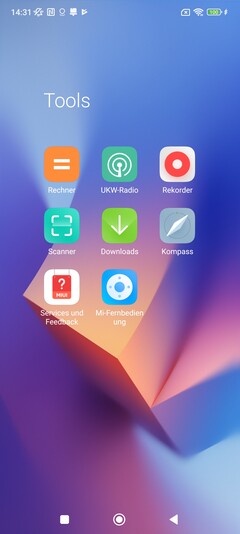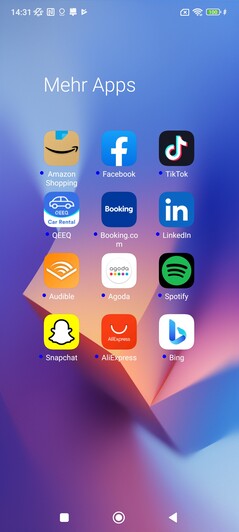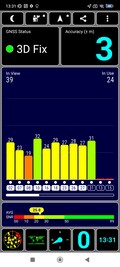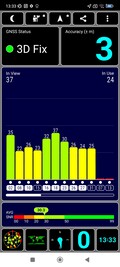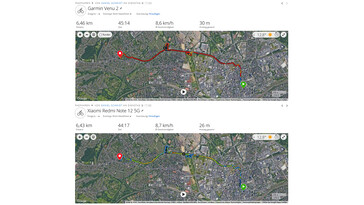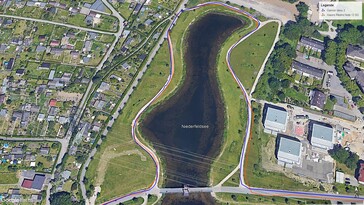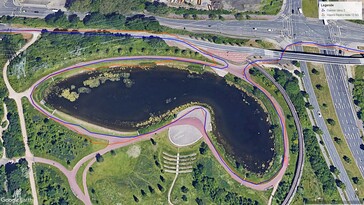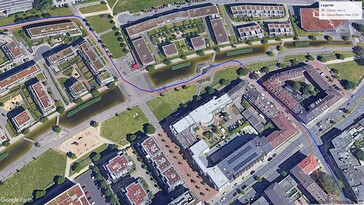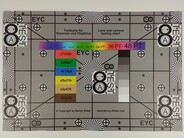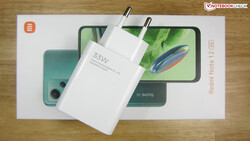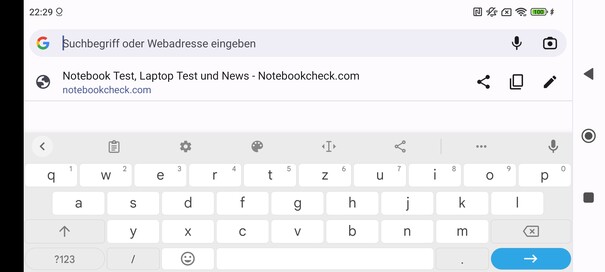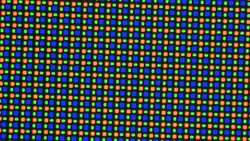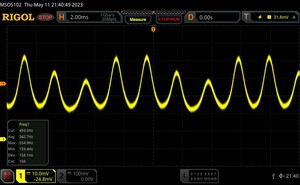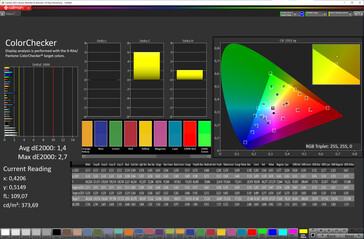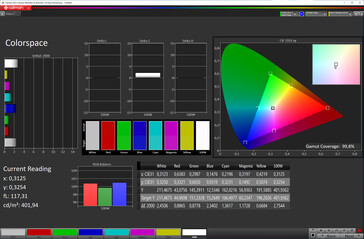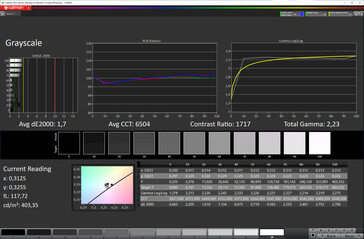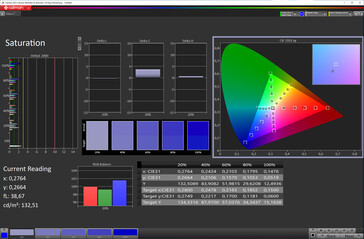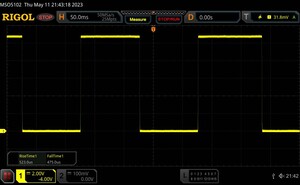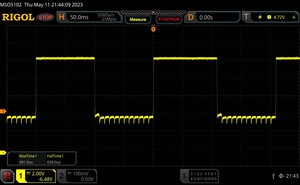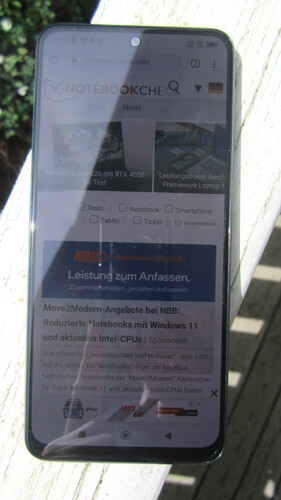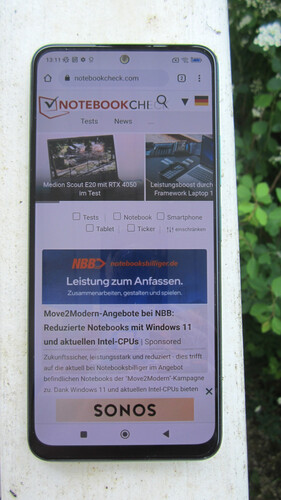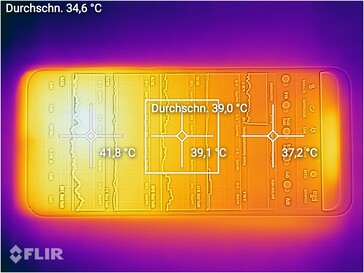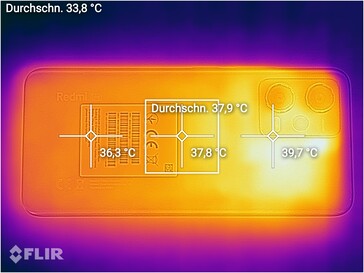Xiaomi Redmi Note 12 5G review: Cheap mid-range with 120 Hz and four-digit brightness
In its Redmi Note series, Xiaomi offers inexpensive but well-equipped smartphones that bridge the gap between the entry-level and mid-range. This concept was implemented in the popular Redmi Note 11 series and has not changed in the successors.
The representatives of the current Redmi series are the Redmi Note 12, Redmi Note 12 5G, Redmi Note 12 Pro 5G and the Redmi Note 12 Pro+ 5G. They cost between US$200-500 and are equipped with an OLED display that offers a refresh rate of 120 Hz as standard. Only the entry-level Redmi Note 12 model does not feature 5G.
Our test candidate, the Redmi Note 12 5G, is the cheapest 5G model in the range and officially costs US$279.99. In terms of performance, the 6.67-inch Xiaomi aims to stand out with its new eight-core SoC Qualcomm Snapdragon 4 Gen 1 and features such as a 48 MP triple camera and a 5000 mAh battery. As befits a Redmi Note smartphone, a power adapter is also included, which delivers charging strength of up to 33 watts.
Possible competitors in comparison
Rating | Date | Model | Weight | Drive | Size | Resolution | Price |
|---|---|---|---|---|---|---|---|
| 81.7 % v7 (old) | 06 / 2023 | Xiaomi Redmi Note 12 5G SD 4 Gen 1, Adreno 619 | 189 g | 128 GB UFS 2.2 Flash | 6.67" | 2400x1080 | |
| 82 % v7 (old) | 05 / 2023 | Honor Magic5 Lite 5G SD 695 5G, Adreno 619 | 175 g | 128 GB UFS 2.2 Flash | 6.67" | 2400x1080 | |
| 82.8 % v7 (old) | 05 / 2023 | Motorola Moto G73 5G Dimensity 930, IMG BXM-8-256 | 181 g | 256 GB UFS 2.2 Flash | 6.50" | 2400x1080 | |
| 85.6 % v7 (old) | 07 / 2022 | Nothing Phone (1) SD 778G+ 5G, Adreno 642L | 193.5 g | 256 GB UFS 3.1 Flash | 6.55" | 2400x1080 | |
| 84.9 % v7 (old) | 04 / 2023 | Samsung Galaxy A34 5G Dimensity 1080, Mali-G68 MP4 | 199 g | 128 GB UFS 2.2 Flash | 6.60" | 2340x1080 | |
| 80 % v7 (old) | 05 / 2022 | Xiaomi Redmi Note 11 SD 680, Adreno 610 | 179 g | 64 GB UFS 2.2 Flash | 6.43" | 2400x1080 | |
| 80.1 % v7 (old) | 05 / 2023 | Xiaomi Redmi Note 12 4G SD 685, Adreno 610 | 188 g | 128 GB UFS 2.2 Flash | 6.67" | 2400x1080 |
Case - Sleek plastic chassis with IP53 rating
You won't find a metal frame, a glass back or the latest generation of Gorilla Glass on the Redmi Note 12 5G, which shouldn't come as a surprise given its price. Its sturdy plastic case doesn't feel particularly high quality, but is very well made. At 189 grams, it's also quite light for a smartphone of its size. Thanks to IP53 certification, it is also protected against dust and splashes of water.
The Redmi Note 12 5G uses the same design as its Redmi Note 12 colleagues and thus hardly differs visually from the Pro models. However, the screen bezel is marginally wider, which still results in a good display-to-surface ratio of around 85 percent. Xiaomi provides no information about the protective glass used for the display. A protective display film is applied to the AMOLED panel ex works.
Xiaomi offers the Redmi Note 12 5G in the three colors Forest Green, Ice Blue and Onyx Gray. All three have a matte, slightly velvety shimmering back cover on which fingerprints hardly leave any traces. A glossy surface finish is only available for the camera module, which protrudes around 2 millimeters from the back.
Equipment - Redmi Note 12 5G with 4/128 GB of memory
The Redmi Note 12 5G comes with 4GB of LPDDR4X RAM and 128GB of UFS 2.2 storage. The latter can be expanded via a microSD card, which can be up to 1 TB in size and can also be formatted in the exFAT file format. If you do without the memory expansion, there is space for 2 nano SIM cards in the card slot.
In addition to NFC, Bluetooth 5.1 and a 3.5 mm jack, there is also an OTG-capable USB-C port that works at USB 2.0 speed. Thanks to the support of DRM Widevine L1, the smartphone can easily play HD streams from Netflix and the like.
microSD card reader
Using our Angelbird AV Pro V60 microSD reference card, the Redmi Note 12 5G achieves a decent copy speed of just over 23 MB/s and also does well in sequential data transfers.
| SD Card Reader - average JPG Copy Test (av. of 3 runs) | |
| Samsung Galaxy A34 5G (Angelbird AV Pro V60) | |
| Motorola Moto G73 5G (Angelbird V60) | |
| Xiaomi Redmi Note 11 (Angelbird AV Pro V60) | |
| Xiaomi Redmi Note 12 4G (Angelbird V60) | |
| Xiaomi Redmi Note 12 5G (Angelbird AV Pro V60) | |
Cross Platform Disk Test (CPDT)
Software - Android 12 only
Basically, buyers of Xiaomi smartphones can assume that their device will receive 2 OS upgrades and security updates every three months for 3 years. This is also the case for the current Redmi series, which is comes with the manufacturer's MIUI 14 user interface, but we do not really understand Xiaomi's software strategy here.
While the Redmi Note 12 is launched with Android 13, the Redmi Note 12 5G and the Redmi Note 12 Pro 5G, which are actually higher in the Redmi hierarchy, only have Android 12. So, the 4G version benefits most from the OS upgrades because it is the only one eligible for an upgrade to Android 15, according to the Xiaomi Security Center. In contrast, our Redmi Note 12 5G test candidate and the Redmi Note 12 Pro 5G will only have Android 14 as the last OS upgrade.
Communication and GNSS - Stable WiFi 5 and good GPS
In terms of WLAN, the Xiaomi Redmi Note 12 5G communicates via WiFi 5. Connected to our Asus ROG Rapture GT-AXE11000 reference router, the smartphone achieves transfer rates of up to 363 MBit/s, which are very stable in both sending and receiving. Rival smartphones also achieve very similar speeds. Only the Samsung Galaxy A34 5G has significantly more WiFi 5 bandwidth to offer thanks to its VHT80 support, while the Nothing Phone (1) supports WiFi 6E.
The mobile frequency range of the Redmi Note 12 5G isn't too extensive at 12 5G bands and 13 LTE bands. So the smartphone doesn't really have any globetrotting qualities, but connectivity issues shouldn't occur in the EU region at least.
| Networking | |
| iperf3 receive AXE11000 | |
| Average of class Smartphone (52 - 1857, n=180, last 2 years) | |
| Samsung Galaxy A34 5G | |
| Honor Magic5 Lite 5G | |
| Motorola Moto G73 5G | |
| Xiaomi Redmi Note 12 5G | |
| Xiaomi Redmi Note 11 | |
| Xiaomi Redmi Note 12 4G | |
| iperf3 transmit AXE11000 | |
| Average of class Smartphone (49.8 - 1828, n=180, last 2 years) | |
| Samsung Galaxy A34 5G | |
| Motorola Moto G73 5G | |
| Honor Magic5 Lite 5G | |
| Xiaomi Redmi Note 12 5G | |
| Xiaomi Redmi Note 12 4G | |
| Xiaomi Redmi Note 11 | |
| iperf3 transmit AXE11000 6GHz | |
| Average of class Smartphone (508 - 1945, n=96, last 2 years) | |
| Nothing Phone (1) | |
| iperf3 receive AXE11000 6GHz | |
| Average of class Smartphone (451 - 1870, n=96, last 2 years) | |
| Nothing Phone (1) | |
The Xiaomi pinpoints its current location via the GPS (L1), Glonass (L1), Galileo (E1) and Beidou (B1) satellite navigation systems. Under testing, it managed to do this both outdoors and indoors at an accuracy of 3 meters.
We also tested the real-world tracking capabilities of the Redmi Note 12 5G by having the smartphone compete against the Garmin Venu2 on a bike ride. Comparing the route recordings, the smartphone shows almost as much precision as the fitness tracker, even if it occasionally deviates few meters in densely built-up areas. Overall, the Redmi Note 12 5G is well suited to navigational tasks.
Telephony and Voice Quality
Two nano SIM cards, or one nano SIM card and one microSD card fit into the hybrid SIM slot of the Redmi Note 12 5G. VoLTE and WiFi calls are supported.
The Redmi Note 12 5G performs well in terms of voice quality. Voices are clearly reproduced at both ends of the line and sound only slightly muffled in hands-free mode.
Cameras - Redmi Note 12 5G with Samsung ISOCELL JN1
The Redmi Note 12 5G's 13 MP selfie camera sits in a punch hole and takes satisfactory photos with decent sharpness and exposure in daylight. It can record videos in Full HD resolution at 30 frames per second at most.
The rear triple camera consists of a 48 MP main sensor from Samsung (ISOCELL JN1), an 8 MP ultra wide-angle camera (Omnivision OV08D) and a 2 MP sensor for macro shots.
The ISOCELL JN1 has a sensor size of 1/2.76 inch and works with an f/1.8 aperture. Using pixel binning, it combines four adjacent pixels into one, increasing the pixel size from 0.64 µm to 1.27 µm and producing 12 MP images. In the camera options, the full sensor resolution can also be used in 48 MP mode. Video recordings are possible at a maximum of Full HD at 30 FPS, are electronically stabilized and offer solid image quality.
In bright light, the Redmi Note 12 5G takes good pictures with its main camera. They show lots of detail and please with both vivid and realistic colors. This is also confirmed in the test lab because the ColorChecker test chart shows no major outliers with a maximum Delta-E of <12. However, image sharpness suffers when subjects are further away and so zoom shots in particular look washed out. Despite the small image sensor, the main camera still captures a lot of light in the dark, but the level of detail and image sharpness are at a low level.
The 8 MP ultra wide-angle camera takes photos with a 118° field of view, but its quality is significantly lower than that of the main camera. Photos are washed out and pixelated, especially at the edges of the image and generally have a low level of detail.
Image comparison
Choose a scene and navigate within the first image. One click changes the position on touchscreens. One click on the zoomed-in image opens the original in a new window. The first image shows the scaled photograph of the test device.
Daylight photo 1Daylight photo 2Ultra wide angle5x zoomLow light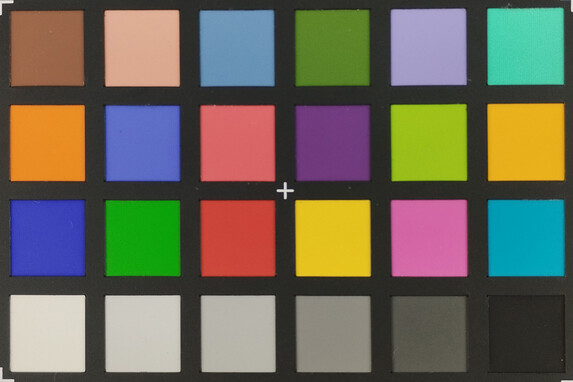
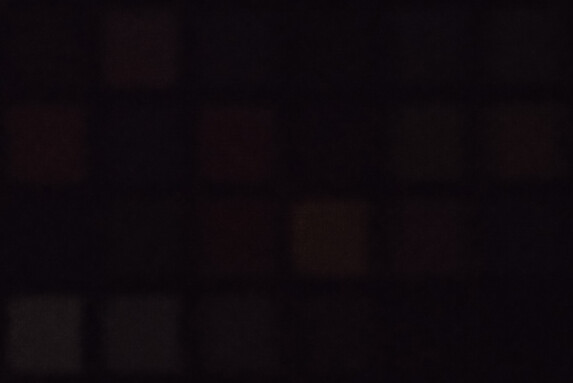
Accessories and Warranty - 33 watt power adapter included
The Xiaomi Redmi Note 12 5G comes with a 33-watt power adapter, a USB cable (type A to C), a transparent protective case, a SIM tool, as well as a quick start guide and warranty information.
Xiaomi provides a 12-month warranty on the Redmi Note 12 5G in the EU. This may differ in other countries and regions, so buyers should double check before purchase.
Input Devices & Operation - Always-on display with 10-second limit
The display of the Redmi Note 12 5G works with a touch sampling rate of 240 Hz, which in combination with the 120 Hz refresh rate makes operation nice and smooth.
Despite the responsive screen, it sometimes falters during use because the Snapdragon 4 Gen 1, supported by 4 GB of RAM, is not a performance miracle. There can be small delays, for example, when waking the smartphone from standby or switching between large numbers of apps open at the same time. But overall, the delays are not particularly noticeable.
Xiaomi's always-on display is able to show elements such as the date, time, battery status and a background motif. However, this does not remain permanently active, but rather is displayed for 10 seconds after tapping the screen. The smartphone can be unlocked biometrically once via the fingerprint sensor integrated in the power button, which works reliably. Authentication via the 2D facial recognition sensor of the selfie camera is just as fast, but less secure.
Display - Four-digit peak brightness
The 6.67-inch AMOLED panel of the Redmi Note 12 5G has a resolution of 2400 x 1080 pixels and runs at a smooth 120 Hz. Alternatively, the refresh rate can be reduced to 60 Hz in the display settings to conserve power. HDR10 and HLG are supported.
For a smartphone in its price range, the Xiaomi delivers above-average brightness. At a peak value of 671 cd/m², it comes very close to the manufacturer's specification of 700 nits in HBM (high brightness mode). It falls short of the promised 1200 nits of peak brightness, but performs very well in the APL18 measurement at 1014 cd/m². This level of brightness is usually only found in much more expensive smartphones.
When the brightness sensor is deactivated, the AMOLED panel of the Redmi Note 12 5G shines at a maximum of 423 cd/m². It dims down to 2.45 cd/m² in the lowest brightness setting.
The AMOLED panel regulates its brightness via pulse width modulation (PWM), which means that screen flickering cannot be ruled out. The rather choppy PWM frequency in the lower brightness range means that sensitive users may have problems. PWM flickering occurs in a frequency range of 159 to 555 Hz at a screen brightness of 54 percent or below. At brightness levels of 54 percent and above, the PWM flickering corresponds to the refresh rate.
| |||||||||||||||||||||||||
Brightness Distribution: 98 %
Center on Battery: 658 cd/m²
Contrast: ∞:1 (Black: 0 cd/m²)
ΔE ColorChecker Calman: 1.4 | ∀{0.5-29.43 Ø4.78}
ΔE Greyscale Calman: 1.7 | ∀{0.09-98 Ø5}
99.8% sRGB (Calman 2D)
Gamma: 2.23
CCT: 6504 K
| Xiaomi Redmi Note 12 5G AMOLED, 2400x1080, 6.7" | Honor Magic5 Lite 5G AMOLED, 2400x1080, 6.7" | Motorola Moto G73 5G IPS LCD, 2400x1080, 6.5" | Nothing Phone (1) OLED, 2400x1080, 6.6" | Samsung Galaxy A34 5G Super AMOLED, 2340x1080, 6.6" | Xiaomi Redmi Note 11 OLED, 2400x1080, 6.4" | Xiaomi Redmi Note 12 4G AMOLED, 2400x1080, 6.7" | |
|---|---|---|---|---|---|---|---|
| Screen | 9% | -44% | 2% | -15% | 13% | -3% | |
| Brightness middle (cd/m²) | 658 | 846 29% | 516 -22% | 620 -6% | 922 40% | 702 7% | 650 -1% |
| Brightness (cd/m²) | 663 | 853 29% | 498 -25% | 625 -6% | 930 40% | 701 6% | 658 -1% |
| Brightness Distribution (%) | 98 | 88 -10% | 89 -9% | 98 0% | 98 0% | 98 0% | 97 -1% |
| Black Level * (cd/m²) | 0.43 | ||||||
| Colorchecker dE 2000 * | 1.4 | 1.3 7% | 2.08 -49% | 1.24 11% | 2.5 -79% | 1 29% | 1.55 -11% |
| Colorchecker dE 2000 max. * | 2.7 | 2.7 -0% | 5.94 -120% | 2.31 14% | 3.6 -33% | 2.3 15% | 2.59 4% |
| Greyscale dE 2000 * | 1.7 | 1.7 -0% | 2.4 -41% | 1.7 -0% | 2.7 -59% | 1.4 18% | 1.8 -6% |
| Gamma | 2.23 99% | 2.19 100% | 2.283 96% | 2.318 95% | 2.09 105% | 2.2 100% | 2.194 100% |
| CCT | 6504 100% | 6570 99% | 7006 93% | 6325 103% | 6661 98% | 6520 100% | 6316 103% |
| Contrast (:1) | 1200 |
* ... smaller is better
Screen Flickering / PWM (Pulse-Width Modulation)
| Screen flickering / PWM detected | 343 Hz | ||
The display backlight flickers at 343 Hz (worst case, e.g., utilizing PWM) . The frequency of 343 Hz is relatively high, so most users sensitive to PWM should not notice any flickering. However, there are reports that some users are still sensitive to PWM at 500 Hz and above, so be aware. In comparison: 53 % of all tested devices do not use PWM to dim the display. If PWM was detected, an average of 8121 (minimum: 5 - maximum: 343500) Hz was measured. | |||
Series of measurements at a fixed zoom level and different brightness settings
In terms of image quality parameters, the Redmi Note 12 5G offers three color schemes: Vivid (preset), Saturated and Standard. There is also the option of adjusting the color temperature. The display achieves the best image quality when the color scheme and color temperature are set to Standard. The AMOLED panel then hardly shows any deviations in terms of colors or grayscale and combines this with an almost ideal color temperature.
Display Response Times
| ↔ Response Time Black to White | ||
|---|---|---|
| 1 ms ... rise ↗ and fall ↘ combined | ↗ 0.523 ms rise | |
| ↘ 0.475 ms fall | ||
| The screen shows very fast response rates in our tests and should be very well suited for fast-paced gaming. In comparison, all tested devices range from 0.1 (minimum) to 240 (maximum) ms. » 3 % of all devices are better. This means that the measured response time is better than the average of all tested devices (20.2 ms). | ||
| ↔ Response Time 50% Grey to 80% Grey | ||
| 1.35 ms ... rise ↗ and fall ↘ combined | ↗ 0.691 ms rise | |
| ↘ 0.658 ms fall | ||
| The screen shows very fast response rates in our tests and should be very well suited for fast-paced gaming. In comparison, all tested devices range from 0.165 (minimum) to 636 (maximum) ms. » 5 % of all devices are better. This means that the measured response time is better than the average of all tested devices (31.6 ms). | ||
Performance - Premiere for the Snapdragon 4 Gen 1
The Xiaomi Redmi Note 12 5G is one of the first smartphones to use the Snapdragon 4 Gen 1. As the successor to the Snapdragon 480+, it is said to run around 15 percent faster than its predecessor. Qualcomm speaks of up to 10 percent higher performance for the GPU. In addition to two fast Cortex-A78 cores that clock at up to 2 GHz, the Snapdragon 4 Gen 1 presented in October 2022 has six energy-saving Cortex-A55 cores that run at a maximum of 1.8 GHz. The Adreno 619 is used as the graphics unit.
The performance of the Redmi Note 12 is enough to narrowly beat the Redmi Note 12, which is equipped with the Snapdragon 685. However, users are unlikely to notice this minor performance difference in practice. The toughest rival for the Snapdragon 4 Gen 1 in the test field is the Snapdragon 695 in the Honor Magic5 Lite 5G. The Xiaomi Redmi Note 12 Pro 5G is even faster and is able to compete with the Samsung Galaxy A34 5G in terms of performance.
Unfortunately, AnTuTu v9 did not run on the Redmi Note 12 5G because the smartphone blocked the connection to the server of the benchmark provider. Almost the same fate befell 3DMark. At least we were able to carry out the slingshot tests.
| UL Procyon AI Inference for Android - Overall Score NNAPI | |
| Samsung Galaxy A34 5G | |
| Xiaomi Redmi Note 12 Pro 5G | |
| Nothing Phone (1) | |
| Average of class Smartphone (3769 - 81594, n=137, last 2 years) | |
| Motorola Moto G73 5G | |
| Xiaomi Redmi Note 12 5G | |
| Average Qualcomm Snapdragon 4 Gen 1 (n=1) | |
| Xiaomi Redmi Note 11 | |
| Xiaomi Redmi Note 12 4G | |
Unlike the Snapdragon 4 Gen 1, the GPU integrated in the new SoC is an old acquaintance on the smartphone market: the Adreno 619 allows the Xiaomi Redmi Note 12 5G to achieve solid 3D performance, which, as shown in the synthetic benchmarks, is slightly above that of the Redmi Note 12. However, some of the other Snapdragon and MediaTek competitors are much faster, including the Xiaomi Redmi Note 12 Pro 5G.
GFXBench (DX / GLBenchmark) 2.7: T-Rex Onscreen | 1920x1080 T-Rex Offscreen
GFXBench 3.0: on screen Manhattan Onscreen OGL | 1920x1080 1080p Manhattan Offscreen
GFXBench 3.1: on screen Manhattan ES 3.1 Onscreen | 1920x1080 Manhattan ES 3.1 Offscreen
GFXBench: on screen Car Chase Onscreen | 1920x1080 Car Chase Offscreen | on screen Aztec Ruins High Tier Onscreen | 2560x1440 Aztec Ruins High Tier Offscreen | on screen Aztec Ruins Normal Tier Onscreen | 1920x1080 Aztec Ruins Normal Tier Offscreen | 3840x2160 4K Aztec Ruins High Tier Offscreen
| 3DMark / Sling Shot Extreme (Vulkan) Unlimited Physics | |
| Samsung Galaxy A34 5G | |
| Motorola Moto G73 5G | |
| Nothing Phone (1) | |
| Xiaomi Redmi Note 12 Pro 5G | |
| Xiaomi Redmi Note 12 5G | |
| Xiaomi Redmi Note 12 4G | |
| Xiaomi Redmi Note 11 | |
| 3DMark / Sling Shot Extreme (Vulkan) Unlimited Graphics | |
| Nothing Phone (1) | |
| Samsung Galaxy A34 5G | |
| Xiaomi Redmi Note 12 Pro 5G | |
| Motorola Moto G73 5G | |
| Xiaomi Redmi Note 12 5G | |
| Xiaomi Redmi Note 12 4G | |
| Xiaomi Redmi Note 11 | |
| 3DMark / Sling Shot Extreme (Vulkan) Unlimited | |
| Nothing Phone (1) | |
| Samsung Galaxy A34 5G | |
| Xiaomi Redmi Note 12 Pro 5G | |
| Motorola Moto G73 5G | |
| Xiaomi Redmi Note 12 5G | |
| Xiaomi Redmi Note 12 4G | |
| Xiaomi Redmi Note 11 | |
| 3DMark / Sling Shot Extreme (ES 3.1) Unlimited Physics | |
| Nothing Phone (1) | |
| Xiaomi Redmi Note 12 Pro 5G | |
| Samsung Galaxy A34 5G | |
| Honor Magic5 Lite 5G | |
| Motorola Moto G73 5G | |
| Xiaomi Redmi Note 12 5G | |
| Xiaomi Redmi Note 12 4G | |
| Xiaomi Redmi Note 11 | |
| 3DMark / Sling Shot Extreme (ES 3.1) Unlimited Graphics | |
| Nothing Phone (1) | |
| Samsung Galaxy A34 5G | |
| Xiaomi Redmi Note 12 Pro 5G | |
| Honor Magic5 Lite 5G | |
| Xiaomi Redmi Note 12 5G | |
| Motorola Moto G73 5G | |
| Xiaomi Redmi Note 12 4G | |
| Xiaomi Redmi Note 11 | |
| 3DMark / Sling Shot Extreme (ES 3.1) Unlimited | |
| Nothing Phone (1) | |
| Xiaomi Redmi Note 12 Pro 5G | |
| Samsung Galaxy A34 5G | |
| Honor Magic5 Lite 5G | |
| Xiaomi Redmi Note 12 5G | |
| Motorola Moto G73 5G | |
| Xiaomi Redmi Note 12 4G | |
| Xiaomi Redmi Note 11 | |
| GFXBench (DX / GLBenchmark) 2.7 / T-Rex Onscreen | |
| Nothing Phone (1) | |
| Samsung Galaxy A34 5G | |
| Motorola Moto G73 5G | |
| Xiaomi Redmi Note 12 Pro 5G | |
| Xiaomi Redmi Note 12 5G | |
| Xiaomi Redmi Note 12 4G | |
| Xiaomi Redmi Note 11 | |
| GFXBench (DX / GLBenchmark) 2.7 / T-Rex Offscreen | |
| Nothing Phone (1) | |
| Xiaomi Redmi Note 12 Pro 5G | |
| Samsung Galaxy A34 5G | |
| Xiaomi Redmi Note 12 5G | |
| Motorola Moto G73 5G | |
| Xiaomi Redmi Note 12 4G | |
| Xiaomi Redmi Note 11 | |
| GFXBench 3.0 / Manhattan Onscreen OGL | |
| Nothing Phone (1) | |
| Xiaomi Redmi Note 12 Pro 5G | |
| Motorola Moto G73 5G | |
| Samsung Galaxy A34 5G | |
| Xiaomi Redmi Note 12 5G | |
| Xiaomi Redmi Note 12 4G | |
| Xiaomi Redmi Note 11 | |
| GFXBench 3.0 / 1080p Manhattan Offscreen | |
| Nothing Phone (1) | |
| Xiaomi Redmi Note 12 Pro 5G | |
| Samsung Galaxy A34 5G | |
| Motorola Moto G73 5G | |
| Xiaomi Redmi Note 12 5G | |
| Xiaomi Redmi Note 12 4G | |
| Xiaomi Redmi Note 11 | |
| GFXBench 3.1 / Manhattan ES 3.1 Onscreen | |
| Nothing Phone (1) | |
| Xiaomi Redmi Note 12 Pro 5G | |
| Samsung Galaxy A34 5G | |
| Motorola Moto G73 5G | |
| Xiaomi Redmi Note 12 5G | |
| Xiaomi Redmi Note 12 4G | |
| Xiaomi Redmi Note 11 | |
| GFXBench 3.1 / Manhattan ES 3.1 Offscreen | |
| Nothing Phone (1) | |
| Xiaomi Redmi Note 12 Pro 5G | |
| Samsung Galaxy A34 5G | |
| Xiaomi Redmi Note 12 5G | |
| Motorola Moto G73 5G | |
| Xiaomi Redmi Note 11 | |
| Xiaomi Redmi Note 12 4G | |
| GFXBench / Car Chase Onscreen | |
| Nothing Phone (1) | |
| Samsung Galaxy A34 5G | |
| Xiaomi Redmi Note 12 Pro 5G | |
| Motorola Moto G73 5G | |
| Xiaomi Redmi Note 12 5G | |
| Xiaomi Redmi Note 12 4G | |
| Xiaomi Redmi Note 11 | |
| GFXBench / Car Chase Offscreen | |
| Nothing Phone (1) | |
| Xiaomi Redmi Note 12 Pro 5G | |
| Samsung Galaxy A34 5G | |
| Motorola Moto G73 5G | |
| Xiaomi Redmi Note 12 5G | |
| Xiaomi Redmi Note 12 4G | |
| Xiaomi Redmi Note 11 | |
| GFXBench / Aztec Ruins High Tier Offscreen | |
| Nothing Phone (1) | |
| Xiaomi Redmi Note 12 Pro 5G | |
| Samsung Galaxy A34 5G | |
| Honor Magic5 Lite 5G | |
| Motorola Moto G73 5G | |
| Xiaomi Redmi Note 12 5G | |
| Xiaomi Redmi Note 12 4G | |
| Xiaomi Redmi Note 11 | |
| GFXBench / Aztec Ruins Normal Tier Onscreen | |
| Nothing Phone (1) | |
| Xiaomi Redmi Note 12 Pro 5G | |
| Samsung Galaxy A34 5G | |
| Motorola Moto G73 5G | |
| Honor Magic5 Lite 5G | |
| Xiaomi Redmi Note 12 5G | |
| Xiaomi Redmi Note 12 4G | |
| Xiaomi Redmi Note 11 | |
| GFXBench / Aztec Ruins Normal Tier Offscreen | |
| Nothing Phone (1) | |
| Xiaomi Redmi Note 12 Pro 5G | |
| Samsung Galaxy A34 5G | |
| Honor Magic5 Lite 5G | |
| Motorola Moto G73 5G | |
| Xiaomi Redmi Note 12 5G | |
| Xiaomi Redmi Note 12 4G | |
| Xiaomi Redmi Note 11 | |
| GFXBench / 4K Aztec Ruins High Tier Offscreen | |
| Nothing Phone (1) | |
| Xiaomi Redmi Note 12 Pro 5G | |
| Samsung Galaxy A34 5G | |
| Honor Magic5 Lite 5G | |
| Xiaomi Redmi Note 12 5G | |
| Motorola Moto G73 5G | |
| Xiaomi Redmi Note 12 4G | |
The Xiaomi Redmi Note 12 5G performs well in web surfing. Delays in page loading rarely occurred in testing.
| Jetstream 2 - 2.0 Total Score | |
| Average of class Smartphone (23.8 - 387, n=152, last 2 years) | |
| Motorola Moto G73 5G (Chrome 111.0.5563.116) | |
| Nothing Phone (1) (Chrome 103) | |
| Xiaomi Redmi Note 12 Pro 5G (Chrome 111) | |
| Samsung Galaxy A34 5G (Chrome 111.0.5563.116) | |
| Xiaomi Redmi Note 12 4G (Chrome 113) | |
| Xiaomi Redmi Note 12 5G (Chrome 113.0.5672.76) | |
| Average Qualcomm Snapdragon 4 Gen 1 (n=1) | |
| Xiaomi Redmi Note 11 (Chrome 101) | |
| Speedometer 2.0 - Result 2.0 | |
| Average of class Smartphone (15.2 - 643, n=128, last 2 years) | |
| Xiaomi Redmi Note 12 Pro 5G (Chrome 111) | |
| Samsung Galaxy A34 5G (Chrome 111.0.5563.116) | |
| Motorola Moto G73 5G (Chrome 111.0.5563.116) | |
| Nothing Phone (1) (Chome 103) | |
| Xiaomi Redmi Note 12 4G (Chrome 113) | |
| Xiaomi Redmi Note 12 5G (Chrome 113.0.5672.76) | |
| Average Qualcomm Snapdragon 4 Gen 1 (n=1) | |
| Xiaomi Redmi Note 11 (Chrome 101) | |
| WebXPRT 4 - Overall | |
| Average of class Smartphone (27 - 306, n=147, last 2 years) | |
| Motorola Moto G73 5G (Chrome 111.0.5563.116) | |
| Samsung Galaxy A34 5G (Chrome 111.0.5563.116) | |
| Xiaomi Redmi Note 12 Pro 5G (Chrome 111) | |
| Nothing Phone (1) (Chrome 103) | |
| Xiaomi Redmi Note 12 5G (Chrome 113.0.5672.76) | |
| Average Qualcomm Snapdragon 4 Gen 1 (n=1) | |
| Xiaomi Redmi Note 12 4G (Chrome 113) | |
| WebXPRT 3 - Overall | |
| Average of class Smartphone (38 - 380, n=35, last 2 years) | |
| Samsung Galaxy A34 5G (Chrome 111.0.5563.116) | |
| Motorola Moto G73 5G (Chrome 111.0.5563.116) | |
| Nothing Phone (1) (Chrome 103) | |
| Xiaomi Redmi Note 12 Pro 5G (Chrome 111) | |
| Xiaomi Redmi Note 12 5G (Chrome 113.0.5672.76) | |
| Average Qualcomm Snapdragon 4 Gen 1 (n=1) | |
| Xiaomi Redmi Note 12 4G (Chrome 113) | |
| Xiaomi Redmi Note 11 (Chrome 101) | |
| Octane V2 - Total Score | |
| Average of class Smartphone (2228 - 121337, n=200, last 2 years) | |
| Xiaomi Redmi Note 12 Pro 5G (Chrome 111) | |
| Motorola Moto G73 5G (Chrome 111.0.5563.116) | |
| Samsung Galaxy A34 5G (Chrome 111.0.5563.116) | |
| Nothing Phone (1) (Chrome 103) | |
| Honor Magic5 Lite 5G (Chrome 112) | |
| Xiaomi Redmi Note 12 5G (Chrome 113.0.5672.76) | |
| Average Qualcomm Snapdragon 4 Gen 1 (n=1) | |
| Xiaomi Redmi Note 12 4G (Chrome 113) | |
| Xiaomi Redmi Note 11 (Chrome 101) | |
| Mozilla Kraken 1.1 - Total | |
| Xiaomi Redmi Note 11 (Chrome 101) | |
| Xiaomi Redmi Note 12 4G (Chrome 113) | |
| Xiaomi Redmi Note 12 5G (Chrome 113.0.5672.76) | |
| Average Qualcomm Snapdragon 4 Gen 1 (n=1) | |
| Samsung Galaxy A34 5G (Chrome 111.0.5563.116) | |
| Nothing Phone (1) (Chrome 103) | |
| Xiaomi Redmi Note 12 Pro 5G (Chrome 111) | |
| Motorola Moto G73 5G (Chrome 111.0.5563.116) | |
| Average of class Smartphone (257 - 28190, n=155, last 2 years) | |
* ... smaller is better
The Xiaomi Redmi Note 12 5G uses UFS 2.2 storage and delivers good performance typical of its class. However, the 4G version of the smartphone is much faster in sequential reading and writing, even though it uses the same memory standard.
| Xiaomi Redmi Note 12 5G | Honor Magic5 Lite 5G | Motorola Moto G73 5G | Nothing Phone (1) | Samsung Galaxy A34 5G | Xiaomi Redmi Note 11 | Xiaomi Redmi Note 12 4G | Xiaomi Redmi Note 12 Pro 5G | Average 128 GB UFS 2.2 Flash | Average of class Smartphone | |
|---|---|---|---|---|---|---|---|---|---|---|
| AndroBench 3-5 | -8% | 55% | 116% | 31% | 19% | 55% | 63% | 19% | 193% | |
| Sequential Read 256KB (MB/s) | 520.09 | 486.17 -7% | 963.54 85% | 1638 215% | 887.41 71% | 895.34 72% | 954.87 84% | 1008.8 94% | 736 ? 42% | 2225 ? 328% |
| Sequential Write 256KB (MB/s) | 505.55 | 420.44 -17% | 808.95 60% | 1351.9 167% | 494.67 -2% | 519.23 3% | 709.51 40% | 865.59 71% | 532 ? 5% | 1838 ? 264% |
| Random Read 4KB (MB/s) | 170.61 | 171.13 0% | 231.38 36% | 240.6 41% | 216.75 27% | 172.95 1% | 261.09 53% | 241.83 42% | 193 ? 13% | 295 ? 73% |
| Random Write 4KB (MB/s) | 161.26 | 149.12 -8% | 220.46 37% | 228.2 42% | 206.14 28% | 163.29 1% | 231.57 44% | 234.21 45% | 186.3 ? 16% | 334 ? 107% |
Gaming - Good performance thanks to Adreno 619
Games run smoothly on the Xiaomi Redmi Note 12 5G, even if you have to reduce the graphics details every now and then. Nevertheless, the Adreno 619 GPU in our review sample makes it the better choice than the 4G version, which has to make do with the weaker Adreno 610.
The Xiaomi Redmi Note 12 5G achieves a good average of 95 FPS in Armajet. In contrast, the frame rate of the Redmi Note 12 is much lower and drops significantly again and again. The small but noticeable performance advantage of the review sample's Adreno 619 GPU is also noticeable in PUBG Mobile. Unlike the Redmi Note 12, you can not only select the HD setting, but the shooter also runs almost constantly at 60 FPS.
Frame rates were determined with our Gamebench test tool.
Emissions - Maximum performance always available
Temperature
At a peak value of 40.3 °C, the Xiaomi Redmi Note 12 5G remains relatively cool under permanent load. The low heat development of the Snapdragon 4 Gen 1 also ensures that the SoC can practically always provide full performance in everyday use. This is further confirmed by the GFXBench stress test.
In the T-Rex test scenario from GFXBench, the test scene is continuously rendered at the same speed from the first to the 30th run, apart from minimal deviations, so it never struggles with performance losses.
Note: We usually run the stress tests with 3DMark. However, because Xiaomi blocks the download of the 3DMark Wild Life benchmarks on the Redmi Note 12 5G, we used GFXBench as an alternative.
(±) The maximum temperature on the upper side is 40.3 °C / 105 F, compared to the average of 35.2 °C / 95 F, ranging from 21.9 to 247 °C for the class Smartphone.
(+) The bottom heats up to a maximum of 39.5 °C / 103 F, compared to the average of 34 °C / 93 F
(+) In idle usage, the average temperature for the upper side is 29.6 °C / 85 F, compared to the device average of 32.9 °C / 91 F.
Speakers
In contrast to the Redmi Note 12, the Redmi Note 12 5G does not feature stereo sound. Instead, you have to make do with the mono sound produced by a speaker located next to the USB-C port. Bass is hardly present and the mids are not too linear. All in all, the sound is satisfactory for the price range.
External audio devices can be connected to the Xiaomi via the 3.5 mm jack or Bluetooth 5.1. The Redmi Note 12 5G supports all common Bluetooth codecs such as AAC, LDAC, LHDC V3/V4 as well as aptX HD, aptX Adaptive Audio and aptX TWS+ Audio.
Xiaomi Redmi Note 12 5G audio analysis
(+) | speakers can play relatively loud (91.5 dB)
Bass 100 - 315 Hz
(-) | nearly no bass - on average 30.6% lower than median
(+) | bass is linear (4.2% delta to prev. frequency)
Mids 400 - 2000 Hz
(±) | reduced mids - on average 5.9% lower than median
(+) | mids are linear (5.2% delta to prev. frequency)
Highs 2 - 16 kHz
(+) | balanced highs - only 3.7% away from median
(+) | highs are linear (3% delta to prev. frequency)
Overall 100 - 16.000 Hz
(±) | linearity of overall sound is average (18.9% difference to median)
Compared to same class
» 23% of all tested devices in this class were better, 10% similar, 68% worse
» The best had a delta of 11%, average was 35%, worst was 134%
Compared to all devices tested
» 43% of all tested devices were better, 8% similar, 49% worse
» The best had a delta of 4%, average was 24%, worst was 134%
Xiaomi Redmi Note 11 audio analysis
(+) | speakers can play relatively loud (89 dB)
Bass 100 - 315 Hz
(-) | nearly no bass - on average 29.8% lower than median
(±) | linearity of bass is average (8.8% delta to prev. frequency)
Mids 400 - 2000 Hz
(+) | balanced mids - only 4.5% away from median
(+) | mids are linear (4.8% delta to prev. frequency)
Highs 2 - 16 kHz
(+) | balanced highs - only 4.4% away from median
(+) | highs are linear (2.9% delta to prev. frequency)
Overall 100 - 16.000 Hz
(±) | linearity of overall sound is average (18.8% difference to median)
Compared to same class
» 22% of all tested devices in this class were better, 10% similar, 68% worse
» The best had a delta of 11%, average was 35%, worst was 134%
Compared to all devices tested
» 42% of all tested devices were better, 8% similar, 50% worse
» The best had a delta of 4%, average was 24%, worst was 134%
Battery life - Charged in 1 hour
Energy Consumption
The Xiaomi Redmi Note 12 5G does not support wireless charging, but it does support fast charging with up to 33 watts. In testing, it takes 65 minutes to bring the 5000 mAh battery from 0 to 100 percent.
The smartphone is rather inconspicuous in terms of power consumption. It is not particularly economical, but is not wasteful either. It consumes more power than the Xiaomi Redmi Note 12 at up to 4.72 watts under load.
| Off / Standby | |
| Idle | |
| Load |
|
Key:
min: | |
| Xiaomi Redmi Note 12 5G 5000 mAh | Motorola Moto G73 5G 5000 mAh | Nothing Phone (1) 4500 mAh | Samsung Galaxy A34 5G 5000 mAh | Xiaomi Redmi Note 11 5000 mAh | Xiaomi Redmi Note 12 4G 5000 mAh | Average Qualcomm Snapdragon 4 Gen 1 | Average of class Smartphone | |
|---|---|---|---|---|---|---|---|---|
| Power Consumption | -14% | -4% | 2% | 6% | 2% | 0% | -37% | |
| Idle Minimum * (Watt) | 0.99 | 0.7 29% | 1 -1% | 0.69 30% | 1.06 -7% | 0.8 19% | 0.99 ? -0% | 0.848 ? 14% |
| Idle Average * (Watt) | 1.98 | 1.2 39% | 1.2 39% | 1.61 19% | 1.93 3% | 1 49% | 1.98 ? -0% | 1.435 ? 28% |
| Idle Maximum * (Watt) | 2.02 | 1.8 11% | 1.5 26% | 1.66 18% | 1.96 3% | 1.5 26% | 2.02 ? -0% | 1.621 ? 20% |
| Load Average * (Watt) | 3.35 | 4.8 -43% | 4.2 -25% | 4.01 -20% | 2.87 14% | 4.8 -43% | 3.35 ? -0% | 6.99 ? -109% |
| Load Maximum * (Watt) | 4.72 | 9.7 -106% | 7.4 -57% | 6.5 -38% | 3.85 18% | 6.7 -42% | 4.72 ? -0% | 11.3 ? -139% |
* ... smaller is better
Power consumption: Geekbench (150 cd/m²)
Power consumption: GFXBench (150 cd/m²)
Battery Life
With its display brightness adjusted to 150 cd/m² and a refresh rate set to 120 Hz, the mid-range smartphone lasts 10:45 hours in simulated web surfing and manages a good 17:45 hours in video playback. This makes it a little less enduring than the Xiaomi Redmi Note 12, which also has a 5000 mAh battery.
| Xiaomi Redmi Note 12 5G 5000 mAh | Honor Magic5 Lite 5G 5100 mAh | Motorola Moto G73 5G 5000 mAh | Nothing Phone (1) 4500 mAh | Samsung Galaxy A34 5G 5000 mAh | Xiaomi Redmi Note 11 5000 mAh | Xiaomi Redmi Note 12 4G 5000 mAh | Xiaomi Redmi Note 12 Pro 5G 5000 mAh | |
|---|---|---|---|---|---|---|---|---|
| Battery runtime | 26% | 39% | 4% | 42% | 16% | 5% | 6% | |
| Reader / Idle (h) | 27.8 | 57.6 107% | 30.2 9% | 49.6 78% | 35 26% | 25.2 -9% | 26.6 -4% | |
| H.264 (h) | 17.8 | 20 12% | 17.7 -1% | 22.7 28% | 17.9 1% | 23.4 31% | 17.4 -2% | |
| WiFi v1.3 (h) | 10.8 | 13.6 26% | 17.4 61% | 15.4 43% | 17.1 58% | 14 30% | 12 11% | 16.3 51% |
| Load (h) | 6.5 | 4.8 -26% | 4.3 -34% | 6.6 2% | 6.8 5% | 5.5 -15% | 5 -23% |
Pros
Cons
Verdict on the Xiaomi Redmi Note 12 5G
The Xiaomi Redmi Note 12 5G continues the tradition of previous Redmi Note smartphones: it offers a lot of hardware for relatively little money and delivers solid mid-range performance. The Snapdragon 4 Gen 1 doesn't exactly turn the light 6.67-inch device into a rocket, but performance is easily sufficient for everyday use. Hardly anything hiccups during use and current games run smoothly.
The Xiaomi Redmi Note 12 5G is a well-equipped mid-range smartphone at a fair price.
The high-quality Redmi Note 12 5G also scores points with its bright AMOLED screen that achieves values of over 1000 cd/m² and its refresh rate of 120 Hz. We also liked the 48 MP camera that takes good quality photos in daylight. The battery runtimes are not outstanding, but quite solid. In addition, the 5000 mAh battery can be recharged rather quickly via the included 33 watt power adapter.
A big point of criticism of the Redmi Note 12 5G is its Android version. Why the smartphone ships with the current MIUI 14 interface that is only based on Android 12 remains a secret only known to the manufacturer. So, users cannot expect more than an upgrade to Android 14. The omitted stereo sound compared with the Redmi Note 12 is also a minus point.
Alternatives to the Redmi Note 12 5G are the Nothing Phone (1) and the Samsung Galaxy A34 5G as well as the 4G version of the Redmi Note 12, which is barely any slower and nearly just as well equipped.
Price and Availability
Xiaomi Redmi Note 12 5G
- 06/02/2023 v7 (old)
Manuel Masiero
Transparency
The selection of devices to be reviewed is made by our editorial team. The test sample was provided to the author as a loan by the manufacturer or retailer for the purpose of this review. The lender had no influence on this review, nor did the manufacturer receive a copy of this review before publication. There was no obligation to publish this review. As an independent media company, Notebookcheck is not subjected to the authority of manufacturers, retailers or publishers.
This is how Notebookcheck is testing
Every year, Notebookcheck independently reviews hundreds of laptops and smartphones using standardized procedures to ensure that all results are comparable. We have continuously developed our test methods for around 20 years and set industry standards in the process. In our test labs, high-quality measuring equipment is utilized by experienced technicians and editors. These tests involve a multi-stage validation process. Our complex rating system is based on hundreds of well-founded measurements and benchmarks, which maintains objectivity. Further information on our test methods can be found here.




